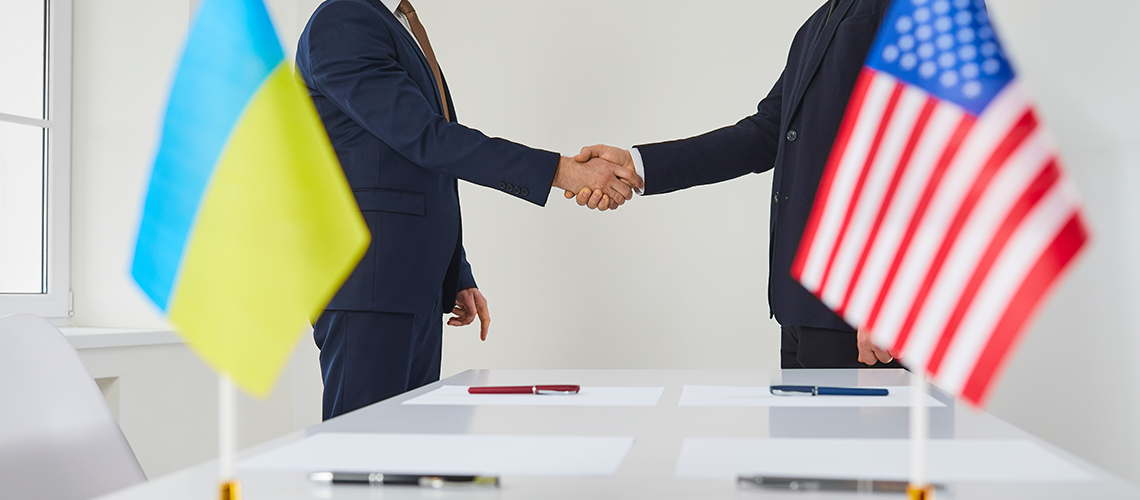Russia-Ukraine: Congressional approval of Ukraine aid package reaffirms world leadership role

In April, the US House of Representatives passed an historic package of military aid for Ukraine, Israel and Taiwan – a bipartisan move in a highly polarised era. To get the package through, House Speaker Mike Johnson – who was elected in October 2023 – defied colleagues in the Republican Party and leaned on support from President Joe Biden’s Democrats.
The breakthrough came after months of delay in which former President Donald Trump and his ‘Make America Great Again’ cadres in Congress opposed aid to Ukraine, raising fears in Europe that the US would abandon its allies.
‘We’re seeing a real splinter in the Republican Party’, says Matt Kaiser, Senior Vice-Chair of the IBA Criminal Law Committee and a partner at KaiserDillon in Washington, DC. ‘Where many people thought that Mike Johnson would come in and be a speaker for the [hardline] Freedom Caucus [group of legislators], we’re seeing that’s just not the case. He’s willing to work with Democrats, but he’s got his own sense of what’s right and wrong’,’ says Kaiser. ‘Clearly, he thought that aid for Ukraine was the right thing to do’.
Legislators worked together to pass a $95bn emergency spending package on 20 April that included $61bn for Ukraine. The key roll call count that paved the way was 316 to 94, a measure of broad, bipartisan support. But it wasn’t always evident that the House would get there, or even that the Speaker, who wields great power under the chamber’s rules, would allow the legislation to come forward.
[Speaker Johnson] has got his own sense of what’s right and wrong. Clearly, he thought that aid for Ukraine was the right thing to do
Matt Kaiser
Senior Vice-Chair, IBA Criminal Law Committee
In February, the US Senate had approved an earlier version of the security bill. Johnson refused to bring it to the House for a vote. Instead, he complained that the Senate had failed to address the migration crisis at the US’ southern border. ‘The mandate of national security supplemental legislation was to secure America's own border before sending additional foreign aid around the world’, Johnson said in a statement.
Indeed, Johnson’s initial blockade of aid to Ukraine appeared to be a position well within the growing Republican tilt toward isolationism under Trump. At the time, a parade of Trump’s congressional allies spoke out against aiding Ukraine and called for Europe to take more of the burden.
The former president has long been seen as anti-Ukraine and pro-Russian. In 2019, during his presidency, Trump was impeached in the House for withholding US weapons from Ukraine. More recently, Trump had said in stump speeches that, if re-elected, he would end the war by requiring Kyiv to negotiate with Moscow, a gambit almost guaranteed to lock-in Russia’s battlefield gains. Trump ‘has certainly accelerated and reinforced’ isolationist sentiments within his party, says Molly Reynolds, a senior fellow in governance studies at The Brookings Institution in Washington, DC.
Johnson soon became the focal point of a pressure campaign by Biden and his cabinet officials, Republican leaders in the House and Senate, and numerous national security officials. White House National Security Adviser Jake Sullivan and Central Intelligence Agency Director Bill Burns laid out the dire stakes for Johnson in detail during a closed-door White House meeting in February.
‘The longer Johnson has been in leadership, the more of a sense he has gotten that, his role as Speaker of the House is different than certainly his role as a rank-and-file member from Louisiana and even different from his role as a peripheral member of Republican leadership’, Reynolds says.
The Biden administration campaign to turn Johnson ‘involved showing him intelligence about what was happening in Ukraine that he would not have been privy to before he was Speaker, and really trying to convince him of the severity of the situation, the consequences of not bringing this to the floor’, she adds. In eventually making his decision, Johnson told Representative Michael McCaul, who chairs the Foreign Affairs Committee, that he wants ‘to be on the right side of history’.
It’s too early to gauge from this legislative episode whether Trump’s isolationism is plateauing or even retreating in the US. One of the more telling moments in the House debate over the aid package came when Representative Marjorie Taylor Green offered an amendment that would have slashed the amount in dollars of Ukraine aid to zero. Only 71 Republicans voted for it.
All along, Trump acolyte Greene had been threatening to call for a no-confidence vote that could unseat Johnson from the speakership if he were to push the Ukraine bill forward. Hardliners had used the same procedure in 2023 to remove former Speaker Kevin McCarthy. This time, however, it appears Democrats are willing to come to Johnson’s assistance, which could take away Greene’s leverage.
The urgency in Congress to provide military aid to Israel in the face of threats from Iran has certainly helped the Ukraine measure advance. Still, the large bipartisan votes in the House were a rebuke of Trump’s backing away from America’s international leadership role. ‘For a short period of time, it assures our allies we are serious about backing them and we are going to try to keep international peace’, says James Thurber, distinguished professor of government and Founder of the Center for Congressional and Presidential Studies at American University in Washington, DC.
Image credit: Studio Romantic/AdobeStock.com
IBA report values economic impact of the legal profession at $1.6tn
A ground-breaking IBA report has found that countries that firmly uphold the rule of law experience greater socio-economic benefits from the everyday contributions of lawyers than governments that impose restrictions on legal rights. In its report on the social and economic impact of the legal profession (the ‘Impact Report’) – the first global study to comprehensively quantify the legal profession’s socio-economic influence – the IBA reveals that the legal profession directly contributes $1.6tn to the global economy, or 1.7 per cent of gross domestic product, via the work of more than 20 million lawyers, paralegals and support staff. This is alongside a further 14 million workers in the supplier sector, including notaries and translators.
The Impact Report also finds that, as threats to the rule of law become more serious in many parts of the world, action must be taken to improve access to representation, strengthen advocacy, bolster education and pursue the highest ethical standards.
‘This landmark study demonstrates, for the first time, in a comprehensive manner, the true contribution of the legal profession through its sustaining of the rule of law’, said IBA President, Almudena Arpón de Mendívil. ‘It shows how effective legal systems, supported by robust and independent legal professionals, can limit the overreach of governments, whilst also supporting economic growth, promoting innovation and education, and combating inequality. But the rule of law is under threat in many parts of the world, including through subtle attrition in many countries with democratic governments.’
Read the full report here.
Read an executive summary here.
IBA launches AI and technology ‘issues in focus’ page

The IBA has added to the ‘issues in focus’ pages on its website with the launch of a hub bringing together content and projects on artificial intelligence (AI) and other technology.
The page will serve as a central resource for visitors to explore the evolving tech landscape, including in relation to AI, which continues to generate a significant amount of both excitement and concern.
The page features a raft of content relating to the subject matter, including features and news analysis articles, committee publications, podcasts, film and reports. It also includes conference and webinar details, both in regard to upcoming events and also recordings of past sessions. The page will be regularly updated to collate relevant content, including from Global Insight magazine, the IBA’s committees and its Legal Policy & Research Unit.
Example content found on the page includes the Global perspectives on protecting against cyber risks report; a filmed keynote address by AI business strategist Zack Kass; and a feature on cyberattacks.
Alongside the page, the IBA has also launched a task force on AI, the law and the legal profession, a presidential initiative encompassing all parts of the Association. The task force is focused on three key areas, namely the regulation of AI; assessing its impact on the legal profession; and advocating for best practices among bar associations. The AI/tech page links to further information on the task force and its goals.
This latest addition complements the IBA’s range of ‘issues in focus’ pages, which have been created over the past few years and respectively cover the climate crisis; ESG (environmental, social and governance); and the Russia-Ukraine war. Each provides a place to view relevant articles, reports, video, news and other output from the IBA on these key subject areas.
Visit the AI/tech page here.
See also:
Global Insight podcast: The Red Sea, the Houthis and the impact on global trade
The Bab el-Mandeb Strait, which sits at the southern tip of the Red Sea, has become an increasingly dangerous chokepoint off the coast of Yemen, with the rebel Houthi group regularly targeting merchant and other ships there linked to Israel, the US or UK, for attack or seizure. The group’s stated motive is ‘retribution’ for the Israel–Hamas conflict. The attacks have been followed by military action from those affected.
The situation has had a significant impact on global trade, with vessels opting to take lengthy routes around the Horn of Africa to avoid the Red Sea, increasing costs, delivery schedules and emissions.
This Global Insight podcast considers the issues for supply chains and international relations, with:
- Charles Dunne, non-resident fellow at the Arab Center in Washington, DC;
- Jan Hoffmann, Chief of Trade Logistics at the United Nations Conference on Trade and Development, Geneva;
- Wesley Wood, Regional Representative for the Middle East on the IBA Maritime and Transport Law Committee, and a partner at Al Tamimi & Company, Dubai; and
- Motaz Salama, researcher in the Gulf Studies Unit at the Cairo-based Al-Ahram Center for Political and Strategic Studies.
Listen to the podcast here.
IBA Corporate and M&A Law Committee completes update of takeover guide
The IBA Corporate and M&A Law Committee has published the final jurisdiction report in its updated takeover guide. The guide presents an overview of takeover rules in 20 countries, divided by jurisdiction. In some jurisdictions, there have been substantial changes in recent years as a result of the influence of prominent authorities, as well as regulatory action, in order to preserve a delicate balance between the interests of various stakeholders.
The countries covered by the guide include Australia, the Cayman Islands, Chile, Italy, Singapore and the US. Each guide indicates its author/s, who may be contacted with questions or suggestions in relation to the laws of that country.
The updated guide is the latest project published by the IBA Corporate and M&A Law Committee. Previous projects include the Committee’s foreign direct investment guide and its minority shareholder rights guide, both of which were updated in 2022.
View the takeover guide here.
Jurisdictional guide to cross-border enforcement of judgments against states published
The IBA Litigation Committee has produced a guide to cross-border enforcement of judgments against states in almost 50 jurisdictions. For each jurisdiction, the aim is to outline the key requirements for enforcing a foreign judgment against a state entity.
Through answers to a series of questions and sub-questions, the guide covers the basic criteria for enforcement of a foreign judgment, the application of sovereign immunity and due process standards and exceptions (service, representation, etc). It also considers how these principles apply where states are involved in armed conflict, which is sadly relevant to a number of litigants around the world currently seeking to recover for wartime damages against aggressor states.
This unique and necessary project has been made possible by the hard work of the Litigation Committee officers and the authors of each guide.
Access the guide here.
New IBA GEI report emphasises the impact of current political and environmental developments on human resources
The IBA Global Employment Institute (GEI) has published its 12th Annual Global Report, covering key trends in human resources (HR) law during 2022 and (parts of) 2023. Based on data from lawyers in 54 countries, the report considers issues such as the aftermath of the Covid-19 pandemic, the shift towards remote work and the challenge of skilled labour shortages. Sustainability and the use of artificial intelligence (AI) are also becoming increasingly relevant in terms of HR management.

Formed in 2010, the GEI aims to develop a global and strategic approach to the main legal issues in the HR field for multinational and worldwide institutions. Each IBA GEI Annual Global Report builds on previous editions, increasing understanding and insight and highlighting international trends in HR law. The reports offer empirical evidence into the development of HR law and the range of employment legislation that exists worldwide.
The report is available to download here.
Technology: ‘ex ante regulation’ and litigation seek to answer concerns over tech harms

Social media platforms are increasingly facing lawsuits alleging that their users are being harmed. Earlier in 2024, New York City filed a lawsuit against Meta and streamers Snapchat, TikTok and YouTube, alleging that their platforms were endangering children’s mental health, promoting addiction and encouraging unsafe behaviour. The lawsuit follows litigation by over 40 US states in October, who together allege that Facebook owner Meta has designed addictive products contributing to a youth mental health crisis.
While Meta, TikTok owner ByteDance and Google – which owns YouTube – didn’t respond to Global Insight’s request for comment, they’ve argued that the allegations are untrue and emphasised their safeguards against harm. Meta, for instance, stated its commitment to giving ‘safe, positive experiences online’ and has highlighted its tools to support families. TikTok’s website emphasises how youth safety is its ‘priority’ and how it doesn’t ‘allow content that may put young people at risk of exploitation, or psychological, physical, or developmental harm.’ YouTube has outlined ways in which it protects child mental health, such as crisis resource panels. Snapchat specifically referred Global Insight to its various safety protocols, which include detailed reviews of features and protections for under-18s.
Another example of the litigious trend is the 2023 case AM v Omegle.com, in which the plaintiff’s lawyers brought a product liability suit against chat website Omegle. They alleged that the site’s design was defective because the type of user-to-user harm their client suffered – online grooming – was foreseeable. AM v Omegle.com settled before court, but it came close to trial and the site’s founder subsequently shut down the site. He said that while the platform ‘punched above its weight in content moderation’, the ‘the stress and expense’ of fighting misuse were a significant factor leading to him shutting down operations.
Commentators have compared these lawsuits to those that helped to curtail the big tobacco companies in the 1990s. But in an industry defined by constant technological innovation, in the time it takes a lawsuit to work its way through the stages of a judicial system, there’s a question as to whether the issues at stake will have been overtaken by something else.
The answer is probably yes, says Angela Flannery, Vice-Chair of the IBA Communications Law Committee and a telecoms, media and technology partner at Australian firm Quay Law Partners. She highlights the slow progress in litigation such as that brought against Facebook by the Australian Privacy Commissioner in 2020, arising from the Cambridge Analytica scandal. The Commissioner alleges that over 300,000 Australians had their data harvested in breach of privacy laws, which Meta disputes. Flannery says that ‘hardly anyone even remembers what [the scandal] is now.’
Related links
- News analysis: Social media: Rise of ‘kidfluencers’ pushes legislators to engage with children’s rights online
- Column: The fight against harmful content
- News analysis: Social media: AI makes it tougher to hold influencers to account
- News analysis: Facebook, oversight and the future of social media regulation
The EU and the UK are taking a view on the idea of what you might call ‘conditional immunity’ […] they’re seeking to drive good behaviour forwards
Julian Hamblin
Senior Vice-Chair, IBA Technology Law Committee
A better alternative to ad hoc lawsuits, she says, is ‘ex ante’ regulation – forward-looking regulatory measures that impose norms and standards on social media platforms, seeking to anticipate – or accommodate – new developments and features. Here, governments have recently intensified their efforts. For example, Australia and the UK now have online safety legislation, which centres on new duties of care for online platforms and fines for non-compliance. There’s also the EU Digital Markets Act (DMA) and Digital Services Act (DSA), which impose obligations and prohibitions on 22 EU-identified ‘gatekeeper’ services run by heavyweights Google’s owner Alphabet, Amazon, ByteDance, Meta and Microsoft.
‘The EU and the UK are taking a view on the idea of what you might call “conditional immunity”’, says Julian Hamblin, Senior Vice-Chair of the IBA Technology Law Committee and a partner at UK firm Trethowans. Via these new regulatory frameworks, ‘they’re seeking to drive good behaviour forwards’, he explains. ‘They’re saying to these companies, “you have to self-regulate, but we’re going to set out the parameters in which you ought to do so.”’
The UK’s Online Safety Act doesn’t stipulate what measures platforms must put in place. Instead, the Act’s regulator, Ofcom, will be giving guidance and issuing codes of practice with clear recommendations and identifying proportionate steps to manage the risks.
Verónica Volman – a lawyer at Argentinian firm RCTZZ – has written on how the DSA should be taken as a basis for the regulation of social media platforms in other jurisdictions. Core to the DSA’s appeal, she says, is that it ‘doesn’t define what “illicit content” is, leaving that definition to each Member State.’ This is key, she says, because frameworks like the DSA shouldn’t intrude upon regulations enacted by other competent authorities by defining such concepts, given the importance of protecting freedom of speech according to each jurisdiction’s standards.
This interpretive ‘gap’ is also vital as technology and social media platforms evolve together. A test of the effectiveness of such regulatory ‘future-proofing’ will probably be the new era of potentially harmful content being ushered in by the misuse of artificial intelligence (AI) to create seamlessly believable fake media. ‘You’ve got some segue into that, in the EU, via the AI Act’, says Hamblin. ‘We’re a bit behind the curve in the UK.’ However, the UK’s Ofcom has ‘expressly acknowledged that AI is going to change the picture faster than legislation can be drafted, and that it’ll need to have flexibility within secondary legislation or in its regulatory powers to deal with it.’
In this regard, Flannery believes the EU’s DSA is still too prescriptive in its focus. She compares it with Australia’s Online Safety Act and its ‘Basic Online Safety Expectations’. She says that ‘if one of the things a platform must do is protect children from content that isn’t age appropriate, that principle applies whether or not it’s considered “real” – in terms of being footage of terrorist or violent activity – or if it’s generated by AI.’ However, she’s fundamentally sceptical that any financial penalty will ever be enough to persuade the social media heavyweights to do more than the minimum to comply.
The question of which approach works best looks set to only intensify as regulators’ relationships with platforms ‘become much more heated’, says Flannery. She points to the pushback in April from lawyers for X – formerly Twitter – concerning a request by Australia’s eSafety Commissioner to globally remove a video of a Sydney bishop being stabbed as the footage depicted ‘gratuitous or offensive violence with a high degree of impact or detail’. X geoblocked Australian users but suggests the request potentially establishes a precedent for censoring speech worldwide.
Creating long-lasting protections against social media harm may require fundamentally rethinking the regulatory-Big Tech relationship, says Lweendo Lucy Haangala, Vice-Chair of the IBA Platforms, E-commerce & Social Media Subcommittee and in-house counsel at international non-governmental organisation ActionAid. ‘Are we upskilling policymakers enough to even understand the issues they’re attempting to tackle?’ she asks. Haangala would like to see regulators working holistically, not confrontationally, with Big Tech. ‘If you don’t learn, you don’t evolve – no matter how big the penalty stick’, she adds.
Image credit: REDPIXEL/AdobeStock.com